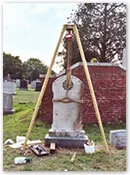Monument Setting
Modern granite monuments are usually constructed from two pieces of granite. The upper headstone section, or die, sits on top of a base stone. The die and base are joined together with monument setting compound, (suppliers list). This compound is similar in texture to window glazing putty, or a very thick dough. Unfortunately it does not provide for structural support, but is designed to fill a void and prevent moisture entry.
The die and base are separated by wooden blocks, and a bead of monument setting compound is laid into the joint. Spacers are then placed in each corner. Most monuments today are set on plastic cushions, (suppliers list). Traditionally monuments were set on four lead strips, one in each corner. I prefer to use wedge leads (suppliers list), which are tapered to absorb any minor variations from manufacturing.
A monument setting pinch bar is then employed to drop the die onto its base. The monument setting compound then squeezes out. The die will drop down until it reaches the spacers. The excess compound is then cut off and may be reused on the next monument. If no spacers are used, the die will keep sinking very slowly, and an uneven ugly joint will be found.
Gravity keeps the die and base joined, with the monument setting compound acting like the grout on a tile. In order to make sure the die and base will stay joined together, a stone epoxy (suppliers list) may be added between the die and base during installation. With proper surface preparation modern stone epoxies are incredibly tenacious.
So why don’t all monuments have stone epoxy added when the sections are joined, because of the cost and extra time it takes to apply it while setting. Monument dealers will cut costs however they can, so many will not add epoxy to strengthen their installations. Remember, as long as the bases stay level, no one will ever know how they are joined together.
Monument Resetting
Monument setting compound has only been around about sixty years. Before that, a monuments die and base were joined with many varying substances depending on who the installer was. A mortar, of sorts, was the most common technique to join monuments together.
Somewhere along the way many monumental shops decided mortar alone was not enough to ensure a lasting installation. The last thing they wanted was a call back, to return and rework a stone for no charge. So, blind pinning was employed.
Blind Pinning is exactly what it implies, pins you do not see once the stone is installed. The concept is very simple. Holes are drilled in both the die and base at exactly the same locations so they match up when joined. Then metal pins are placed in the holes, and usually mortared in place. The basic thinking was that if the monument was knocked or began to lean the pins would prevent a complete failure, and the damage this may cause.
The one thing that many monument setters of the day did not realize, was what the pins, dowels, rods, or connectors were composed from, would have grave significance to the future of the monument. (Please read Furious metal dowels.)
Monument resetting may be very similar to modern monument setting; then again it may be very different. If it is desired to use only materials that were available from the time of the original installation, then a mortar should be employed. This procedure is very effective, but can be a bit messy. Clean up of excess mortar must be done quickly and thoroughly, to avoid the staining of the monument.
Regardless of how a monument is to be reset, the preparation of the surfaces to be joined is essential. All old mortars should be removed by chiseling them off. Then all surfaces to be joined should be washed and dried thoroughly.
If a monument setting compound is to be used, it should always be used in conjunction with a stone epoxy.
Depending on the thickness and height of a monument new blind pinning may be installed. Modern pinning should be constructed of a material that will not rust. Stainless steel is preferred by many, but fiberglass rods are also a good alternative.
It is not recommended to install pinning in a stone such as slate or sandstone, as cracking is likely to develop at the dowel point.
Once all the sections of a monument have been disassembled and cleaned the reassembly or resetting may begin. As mentioned in the foundation section, a level surface should be prepared for the base. Lay the base on the gravel and sand and align with the row it is placed in. Then pry up the low end and level with more sand and gravel as needed. Be sure to jump down on the base to seat it, keep checking until it is set level.
Re-grade with dirt around the base to lock it in place, and prevent movement.
Reset each stone section as described above until completion.
Key Words
Historical
Monument Setting
Pinning
Resetting


